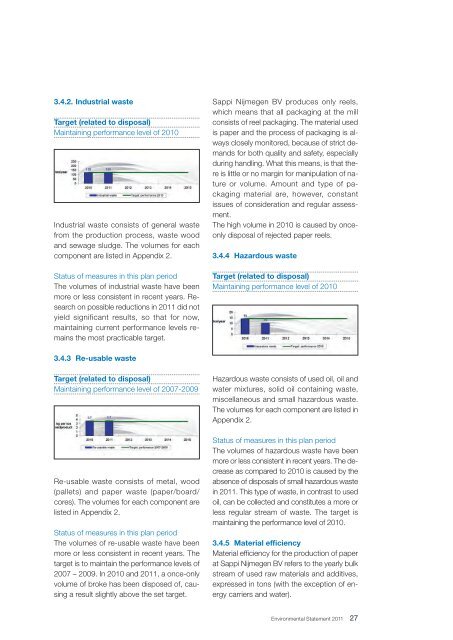2011 Environmental Statement 1.8 MB - Sappi
2011 Environmental Statement 1.8 MB - Sappi
2011 Environmental Statement 1.8 MB - Sappi
Create successful ePaper yourself
Turn your PDF publications into a flip-book with our unique Google optimized e-Paper software.
3.4.2. Industrial waste<br />
Target (related to disposal)<br />
Maintaining performance level of 2010<br />
Industrial waste consists of general waste<br />
from the production process, waste wood<br />
and sewage sludge. The volumes for each<br />
component are listed in Appendix 2.<br />
Status of measures in this plan period<br />
The volumes of industrial waste have been<br />
more or less consistent in recent years. Research<br />
on possible reductions in <strong>2011</strong> did not<br />
yield significant results, so that for now,<br />
maintaining current performance levels remains<br />
the most practicable target.<br />
3.4.3 Re-usable waste<br />
Target (related to disposal)<br />
Maintaining performance level of 2007-2009<br />
Re-usable waste consists of metal, wood<br />
(pallets) and paper waste (paper/board/<br />
cores). The volumes for each component are<br />
listed in Appendix 2.<br />
Status of measures in this plan period<br />
The volumes of re-usable waste have been<br />
more or less consistent in recent years. The<br />
target is to maintain the performance levels of<br />
2007 – 2009. In 2010 and <strong>2011</strong>, a once-only<br />
volume of broke has been disposed of, causing<br />
a result slightly above the set target.<br />
<strong>Sappi</strong> Nijmegen BV produces only reels,<br />
which means that all packaging at the mill<br />
consists of reel packaging. The material used<br />
is paper and the process of packaging is always<br />
closely monitored, because of strict demands<br />
for both quality and safety, especially<br />
during handling. What this means, is that there<br />
is little or no margin for manipulation of nature<br />
or volume. Amount and type of packaging<br />
material are, however, constant<br />
issues of consideration and regular assessment.<br />
The high volume in 2010 is caused by onceonly<br />
disposal of rejected paper reels.<br />
3.4.4 Hazardous waste<br />
Target (related to disposal)<br />
Maintaining performance level of 2010<br />
Hazardous waste consists of used oil, oil and<br />
water mixtures, solid oil containing waste,<br />
miscellaneous and small hazardous waste.<br />
The volumes for each component are listed in<br />
Appendix 2.<br />
Status of measures in this plan period<br />
The volumes of hazardous waste have been<br />
more or less consistent in recent years. The decrease<br />
as compared to 2010 is caused by the<br />
absence of disposals of small hazardous waste<br />
in <strong>2011</strong>. This type of waste, in contrast to used<br />
oil, can be collected and constitutes a more or<br />
less regular stream of waste. The target is<br />
maintaining the performance level of 2010.<br />
3.4.5 Material efficiency<br />
Material efficiency for the production of paper<br />
at <strong>Sappi</strong> Nijmegen BV refers to the yearly bulk<br />
stream of used raw materials and additives,<br />
expressed in tons (with the exception of energy<br />
carriers and water).<br />
<strong>Environmental</strong> <strong>Statement</strong> <strong>2011</strong> 27

















